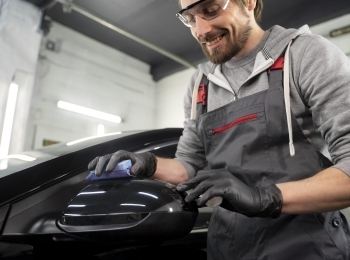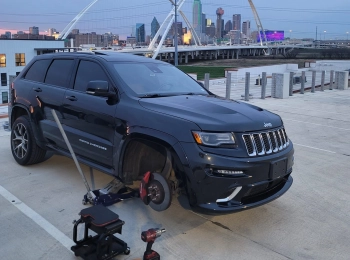If your coolant reservoir is empty but no leaks are visible, it usually means coolant is escaping inside the engine, evaporating as steam, or seeping from small hidden cracks or components you can’t easily see. This problem can be caused by issues like a blown head gasket, faulty caps, heater core leaks, or hairline cracks in the reservoir or radiator. Even if no puddles form under your car, the coolant is still leaving the system and must be tracked down before it leads to overheating and costly engine damage.
In this guide, we’ll cover 7 hidden causes of coolant loss without visible leaks, explain the warning signs for each, and show what steps you can take to prevent long-term problems.
Table of Contents
- 1. Internal Engine Leak (Blown Head Gasket or Cracked Engine Block)
- 2. Evaporation From a Hot Reservoir
- 3. Heater Core Problems
- 4. Radiator Cap or Pressure Issues
- 5. Small, Hidden Hose Leaks That Dry Up Before You Notice
- 6. Coolant Burning Off in the Engine
- 7. Reservoir or Radiator Hairline Cracks
- What To Do If Your Coolant Reservoir Is Empty but No Leaks Are Found
- Preventing Future Coolant Loss
- Final Thoughts
- FAQs
1. Internal Engine Leak (Blown Head Gasket or Cracked Engine Block)
One of the most serious hidden causes is an internal engine leak. This usually happens when a head gasket fails or a crack develops in the engine block or cylinder head. Instead of leaking onto the ground, coolant seeps directly into the engine’s combustion chamber or mixes with the oil.
Signs to watch for:
- White smoke from the exhaust (caused by coolant burning inside the engine)
- Milky or foamy oil on the dipstick
- Sweet smell from the tailpipe
- Engine running rough or misfiring
Why it matters: A blown head gasket can quickly escalate into total engine failure if not addressed. It’s not a DIY job for most people—you’ll need a mechanic to test for combustion gases in the coolant or to perform a compression test.
2. Evaporation From a Hot Reservoir
Sometimes, the coolant reservoir cap is loose or faulty, allowing steam to escape. When coolant heats up, it expands and pressurizes the system. A worn or cracked cap may not seal properly, so instead of circulating back into the reservoir, coolant evaporates as vapor.
Signs to watch for:
- Crusty, dried coolant residue near the reservoir cap
- Reservoir cap that feels loose or damaged
- No visible puddles, but coolant slowly disappears over time
Why it matters: This is one of the easier fixes. Replacing the cap costs very little compared to major engine repairs, and it can stop hidden coolant loss immediately.
3. Heater Core Problems
Your car’s heater core is like a small radiator located inside the dashboard. It uses engine coolant to heat the cabin. If the heater core is damaged, coolant may leak inside the car, not on the ground.
Signs to watch for:
- Foggy windows with a greasy film
- Sweet smell inside the cabin
- Damp carpets near the passenger side floor
- Weak or no heat from the vents
Why it matters: Breathing in antifreeze fumes is unhealthy, and if the core fully fails, you could lose a large amount of coolant quickly. Replacing a heater core can be labor-intensive, but catching the issue early saves you from costly repairs.
4. Radiator Cap or Pressure Issues
Even if the radiator looks fine, a faulty radiator cap can cause pressure loss. The cooling system works under pressure to prevent boiling. A weak or failing radiator cap allows coolant to escape as steam or overflow without leaving puddles.
Signs to watch for:
- Coolant stains around the radiator neck
- Overheating even with full coolant
- Bubbling sounds after shutting off the engine
Why it matters: Just like the reservoir cap, a radiator cap is inexpensive to replace but plays a huge role in keeping your system sealed. Ignoring it can cause gradual coolant loss and overheating.
5. Small, Hidden Hose Leaks That Dry Up Before You Notice
Not all leaks leave puddles. Sometimes, hoses develop pinhole leaks that only spray coolant when the engine is hot and pressurized. By the time you check, the coolant may have evaporated, leaving no visible sign.
Signs to watch for:
- Dried, white or green crust around hose connections
- Sweet smell after driving, but no puddles under the car
- Slight overheating during long drives
Why it matters: These leaks tend to worsen over time. A small pinhole today can burst tomorrow, leaving you stranded. Inspect hoses carefully or have a mechanic perform a pressure test to reveal hidden leaks.
6. Coolant Burning Off in the Engine
Sometimes, coolant can slowly seep into the combustion chamber due to minor gasket wear or microscopic cracks. Unlike a dramatic head gasket failure, this process is slower and harder to detect.
Signs to watch for:
- Gradual coolant loss over weeks or months
- Occasional white exhaust smoke on startup
- Strong exhaust smell after idling
Why it matters: This is tricky because it doesn’t always cause immediate overheating. However, burning coolant reduces lubrication in the engine, which can shorten its lifespan.
7. Reservoir or Radiator Hairline Cracks
Plastic components like the coolant reservoir or radiator tank can develop hairline cracks that only open when hot. These tiny cracks release steam instead of liquid, so you won’t see puddles on the ground.
Signs to watch for:
- Small dried streaks of coolant on the outside of the reservoir
- Coolant levels dropping after long drives
- Reservoir that looks discolored or brittle
Why it matters: Plastic parts weaken over time, especially in hot climates. Replacing a cracked reservoir or radiator before it fails completely prevents sudden coolant loss on the road.
What To Do If Your Coolant Reservoir Is Empty but No Leaks Are Found
- Check caps first. Replace the coolant reservoir cap and radiator cap if they look worn.
- Inspect hoses and connections. Look closely for dried residue, cracks, or loose clamps.
- Monitor exhaust and oil. White smoke or milky oil means coolant is mixing with combustion or oil.
- Perform a pressure test. This forces the system to hold pressure and reveals hidden leaks.
- Don’t ignore overheating. Even if you refill the coolant, overheating signals a deeper issue.
Preventing Future Coolant Loss
The best way to avoid future coolant mysteries is to keep up with regular maintenance. Here are some tips:
- Flush and replace coolant at the intervals recommended by your vehicle manufacturer.
- Inspect hoses and radiator at every oil change.
- Replace caps and worn parts before they fail.
- Pay attention to new smells, smoke, or dashboard warning lights.
By staying proactive, you can stop problems before they become serious and extend the life of your engine.
Final Thoughts
Finding your coolant reservoir empty but no leaks is unsettling, but now you know the hidden causes that might be at play. From small fixes like replacing a cap to serious issues like a head gasket failure, the key is not to ignore the warning signs.
When coolant disappears without explanation, it’s your engine telling you something is wrong. Catching it early means avoiding thousands of dollars in repairs and keeping your car reliable on the road.
If you stay alert, check your coolant often, and act quickly when levels drop, you’ll protect your engine from overheating and ensure many more miles of safe driving.
FAQs
Why is my coolant reservoir empty but there are no visible leaks?
If your coolant reservoir is empty but you don’t see leaks, coolant may be escaping inside the engine, evaporating as steam, or seeping from tiny cracks that only open when the engine is hot.
Can coolant evaporate without a leak?
Yes, coolant can evaporate if the reservoir cap or radiator cap is faulty. Steam escapes under heat and pressure, making it look like the coolant simply disappeared.
Does a blown head gasket cause coolant loss with no leaks?
Yes. A blown head gasket can push coolant into the combustion chamber where it burns off, leaving no puddles but causing white smoke from the exhaust.
What are the signs of coolant mixing with oil?
If coolant mixes with oil, you may notice a milky or frothy appearance on the dipstick, engine overheating, or white exhaust smoke. This usually means internal engine damage.
Why does my car overheat if there are no leaks?
Your car can still overheat if coolant levels are low due to hidden leaks, bad caps, heater core issues, or internal engine problems. Overheating is a major warning sign.
How do I find hidden coolant leaks?
A pressure test is the best way to find hidden leaks. This test forces the cooling system to hold pressure, revealing cracks, pinholes, or faulty connections you can’t see otherwise.
Is it safe to keep driving with an empty coolant reservoir?
No, driving with an empty coolant reservoir risks overheating, warped cylinder heads, and costly engine damage. Always refill and diagnose the cause before driving again.













Leave a Reply